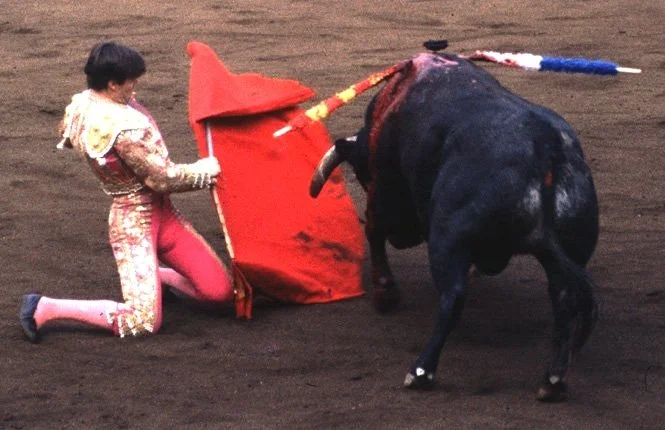Espartaco – a Great Torero
Jock Richardson
I trust that nobody reading either my remark about Espartaco in Part 1 of my Castellón impressions, “It took the great – dare I say that – Espartaco years to marry grace and style with technique just as many others did,” and Tristan’s partial quotation of it in his Carlos Crivell piece, to mean that I have, or ever had, any qualms about the greatness of Espartaco. I was hoping, by daring to call him “great”, to distance myself from those aficionados who had created the situation in which, “Despite this success and his popularity with the Spanish public, rare was the occasion on which aficionados and the taurine critics praised Espartaco.” There were plenty of people like that out there, and many a bar room argument I lost trying to bring them to their taurine senses. From the first novillada in which I saw him, in El Escorial in 1978, in which he cut four ears and two tails; through dozens of corridas, including one in Jaén in 1987 in which he stopped the clock for us while cutting three ears off a Toros de El Torero and a Sancho Álvaro substitute; and multiple ear triumphs in such places as Huesca, Tafalla and Bilbao, I never had any qualms about Espartaco’s ability to marry grace and style with knowledge of toros and taurine technique: in other words, to be a great torero.
Espartaco had a successful feria in Santander in 1989, cutting three ears in his corrida and ending up as the feria triunfador. His toreo was to play a part in one of the most exciting afternoons of my life as an aficionado.
For many years, it was a tradition of ours to sail across the bay in Santander to Pedreña to eat sardines on at least one of the days of the Feria de Santiago. In 1989, our younger son and a friend had joined us for the feria, and we had arranged that our friend Fernando Arámbulu, erstwhile Colombian correspondent of El Ruedo, be one of our company on the trip to Pedreña. It was to prove to be one of the most memorable afternoons of my taurine life. When we met near the embarcadero to catch the ferry, Fernando was accompanied by an old friend. He was introduced as Agustín Sánchez. Fernando asked if we minded if he joined our excursion. Of course we did not. A quiet, well-dressed gentleman, he did not reveal much about himself other than the fact that he was a rabid aficionado, something he confirmed in our after-luncheon discussions. The six of us ate our sardines, drank our wine, and spent the afternoon discussing whether Espartaco was un torero de época or merely una máquina de torear. The paper tablecloth on which we illustrated the discussion lay buried in our attic for years and was tangible evidence that at least six aficionados had no doubt that Espartaco’s little used title of “torero de época” had been well-earned.
By the time we had re-crossed the bay, we had obviously established our credentials as aficionados with Agustín and he started to confide in us. “I was a novillero, you know; I fought with Manolete and have an entry in the Cossío.” (He had two, in different volumes.) Many a man would have told us that within minutes of our meeting rather than leaving it for four hours, but Agustín was a modest man and did not need to draw attention to his exploits. By the time we had walked the two hundred yards to the Hotel Bahia, he had told us that he was from Soria, was now a doctor in Linares, had a ganadería, puro de núñez, from which he found it difficult to sell the produce because he was not Juan Pedro Domecq, and invited us to attend Fernando Lozano, a good friend of his, in his room before the corrida.
The adventure with Lozano was a memorable aspect of that memorable afternoon, but is irrelevant to the torero of Espartaco, so must be left in the memory box for now.
Nine days after these events, we saw Espartaco again in Azpeitia. His performance that day proved yet again that this matador, much maligned by members of the cognoscenti, was indeed a truly great torero. He cut two ears off each of his bulls. I made no record of the corrida, so it became a memory and an entry in my list of corridas seen. It was joy to find it immortalised in the recently published collection of the Diario 16 reports of the Feria de Azpeitia from 1985 to 1996 by Barquerito: Toros en Azpeitia.
This is a book every aficionado should read. Even if they have never been to Azpeitia – maybe never heard of it – it will tell them much about toros, toreros, perfect taurine writing and reporting, their own afición and that of others. One entry is devoted to the corrida in 1989 and, coming as it did 34 years after the events described, reminded me of just why Espartaco contributed so much to my enjoyment of la fiesta and why I think he was a torero de época. It records his ability to connect with the public, from the rowdy members of the peña in the sol to the elite of aficionados of the province; his ability to take a bull that refused to charge, repeat or put its head down, and, by finding the correct distances and applying the wisdom of taurine technique, turn it into a charging machine applauded en el arrastre; his dedication to a small-town plaza as if it were La Maestranza or Las Ventas; and his total commitment to his profession.
[The Club Taurino of London has just announced that Espartaco will be their guest of honour at this year’s Madrid Lunch. - TW]
